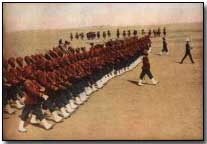Battles - The Battle of Nasiriyeh, 1915
 The Battle of Nasiriyeh
formed the second part of regional British Commander-in-Chief
Sir John
Nixon's summer 1915 offensive on the Mesopotamian Front. Having secured the
capture of Amara in
spectacular fashion in early June 1915 Nixon was keen to extend British
influence over the whole of southern Mesopotamia by displacing the Turkish
army from Nasiriyeh and installing an Anglo-Indian force in its stead.
The Battle of Nasiriyeh
formed the second part of regional British Commander-in-Chief
Sir John
Nixon's summer 1915 offensive on the Mesopotamian Front. Having secured the
capture of Amara in
spectacular fashion in early June 1915 Nixon was keen to extend British
influence over the whole of southern Mesopotamia by displacing the Turkish
army from Nasiriyeh and installing an Anglo-Indian force in its stead.
The British experience to date in the Mesopotamia campaign had been uniformly impressive, at least on paper. Basra, now the British (and Nixon's) HQ, had initially fallen in November 1914 directly following Turkey's entry into World War One.
Shaiba had followed the next month, and since then the British force had continued to harry and push back the Turkish force further up the River Tigris, at Qurna in April 1915 and latterly Amara (which a small British force numbering around 100 had succeeded in capturing under the command of Sir Charles Townshend).
Such a rapid scroll of success however masked a number of critical weaknesses in the British position. Desperately ill-equipped and scandalously short of medical supplies, Nixon - like Townshend - nevertheless regarded the Ottoman ability to conduct war with contempt, and was complacent that further success could be achieved in spite of growing difficulties with his force's supply lines.
Consequently he instructed George Gorringe and 30th Brigade to push on and capture the main Turkish supply base at Nasiriyeh on the inundated banks of the River Euphrates.
Thus on 27 June 1915 a combined Anglo-Indian force began their attack upon the Turkish garrison at Nasiriyeh in searing heat - 115 degrees Fahrenheit - and while plagued by fierce mosquitoes. Sited some 110km west of Qurna Nasiriyeh was itself surrounded by floods, the plains inhabited by up to 20,000 aggressive Budhoos tribes hostile to British and Turk alike.
Gorringe's task was an unenviable one, with its requirement to carry equipment and artillery in shallow draught boats or over land as necessary. Operating under heavy - and accurate - Turkish field gun fire the British first dismantled a Turk-constructed solid earthwork constructed across the Hakika Channel, an operation that took 36 hours.
This accomplished, Gorringe's force spent a further four days clearing Turk field guns from the river bank as they progressed upstream.
 The
port of Suk-es-Sheyukh quickly surrendered to the British without shots
being fired. However 10km from Nasiriyeh a Turk force was waiting for
Gorringe.
The
port of Suk-es-Sheyukh quickly surrendered to the British without shots
being fired. However 10km from Nasiriyeh a Turk force was waiting for
Gorringe.
Unable to progress by river the British were obliged to move on foot either side of the river bank. Gorringe's force dug in some 3km ahead of the waiting Turks pending further infantry support.
Gorringe attempted an abortive attack - by the 24th Punjabis - upon a Turkish outpost on the left bank before withdrawing in the face of an ambush by Budhoos. He waited once again for additional support, his men visibly wilting in the searing heat and from disease, with more than half his men falling ill.
Belatedly the main attack on the Turkish position began at dawn on 24 July following a heavy bombardment, with each side putting around 5,000 troops in the field. With the assistance of the Royal Navy the infantry stormed and secured the Turk positions. The combination of infantry and gunboat support was effective in dispersing Turkish opposition. Nasiriyeh itself soon fell and its Turkish defenders retreated to Kut.
Casualties were once again high. The British lost 500 men in battle alone, although many more died from exhaustion and disease. The Turkish army suffered heavier casualties: 500 dead plus a further 1,000 wounded, along with 1,000 men taken prisoner.
Once again the British had experienced success in the battlefield; and once more Sir John Nixon turned his thoughts increasingly to the capture of Baghdad itself; he did not allow the parlous state of the British supply lines and absence of medical supplies to dissuade him from continuing his advance, supported by the Indian government.
Click here to view a map charting operations in Mesopotamia through to 1917.
Photographs courtesy of Photos of the Great War website
"Harry Tate" was the nickname given by British pilots to the R.E.8 aircraft
- Did you know?
